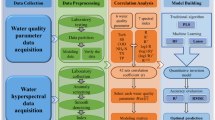Abstract
The estimation of oil spill coverage is an important part of monitoring of oil spills at sea. The spatial resolution of images collected by airborne hyper-spectral remote sensing limits both the detection of oil spills and the accuracy of estimates of their size. We consider at-sea oil spills with zonal distribution in this paper and improve the traditional independent component analysis algorithm. For each independent component we added two constraint conditions: non-negativity and constant sum. We use priority weighting by higher-order statistics, and then the spectral angle match method to overcome the order nondeterminacy. By these steps, endmembers can be extracted and abundance quantified simultaneously. To examine the coverage of a real oil spill and correct our estimate, a simulation experiment and a real experiment were designed using the algorithm described above. The result indicated that, for the simulation data, the abundance estimation error is 2.52% and minimum root mean square error of the reconstructed image is 0.030 6. We estimated the oil spill rate and area based on eight hyper-spectral remote sensing images collected by an airborne survey of Shandong Changdao in 2011. The total oil spill area was 0.224 km2, and the oil spill rate was 22.89%. The method we demonstrate in this paper can be used for the automatic monitoring of oil spill coverage rates. It also allows the accurate estimation of the oil spill area.
Similar content being viewed by others

References
Cococcioni M, Corucci L, Masini A, Nardelli F. 2012. SVME: an ensemble of support vector machines for detecting oil spills from full resolution MODIS images. Ocean Dynamics, 62(3): 449–467.
Hyvärinen A, Karhunen J, Oja E. 2001. Independent Component Analysis. Wiley and Sons, New York. 476p.
Hyvärinen A, Oja E. 1997. A fast fixed-point algorithm for independent component analysis. Neural Computation, 9(7): 1483–1492.
Jha M N. 2009. Development of Laser Fluorosensor Data Processing System and GIS Tools for Oil Spill Response. University of Calgary, Calgary, Alberta. 124p.
Keshava N, Mustard J F. 2002. Spectral unmixing. IEEE Signal Process ing Magazine, 19(1): 44–57.
Kessle J D, Valentine D L, Redmond M C et al. 2011. A persistent oxygen anomaly reveals the fate of spilled methane in the deep Gulf of Mexico. Science, 331(6015): 312–315.
Lee D D, Seung H S. 1999. Learning the parts of objects by non-negative matrix factorization. Nature, 401(6755): 788–791.
Leifer I, Lehr W J, Simecek-Beatty D et al. 2012. State of the art satellite and airborne marine oil spill remote sensing: application to the BP Deepwater Horizon oil spill. Remote Sensing of Environment, 124: 185–209.
Lennon M, Babichenko S, Thomas N et al. 2006. Detection and mapping of oil slicks in the sea by combined use of hyperspectral imagery and laser induced fluorescence. Earsel Eproceedings, 5(1): 120–128.
Lu Y C, Li X, Tian Q J et al. 2013. Progress in marine oil spill optical remote sensing: detected targets, spectral response characteristics, and theories. Marine Geodesy, 36(3): 334–346.
Mirzal A. 2014. NMF versus ICA for blind source separation. Advances in Data Analysis and Classification, 1–24, http://dx.doi.org/10.1007/s11634-014-0192-4.
Nascimento J M P, Dias J M B. 2005. Does independent component analysis play a role in unmixing hyperspectral data? IEEE Transactions on Geoscience and Remote Sensing, 43(1): 175–187.
Ramsey III E, Rangoonwalaa A, Suzuoki Y, Jones C E. 2011. Oil detection in a coastal marsh with polarimetric synthetic aperture radar (SAR). Remote Sensing, 3(12): 2630–2662.
Srivastava H, Singh T P. 2010. Assessment and development of algorithms to detection of oil spills using MODIS data. Journal of the Indian Society of Remote Sensing, 38(1): 161–167.
Wang J, Chang C I. 2006a. Applications of independent component analysis in endmember extraction and abundance quantification for hyperspectral imagery. IEEE Transactions on Geoscience and Remote Sensing, 44(9): 2601–2616.
Wang J, Chang C I. 2006b. Independent component analysisbased dimensionality reduction with applications in hyperspectral image analysis. IEEE Transactions on Geoscience and Remote Sensing, 44(6): 1586–1600.
Winter M E. 1999. N-FINDR: an algorithm for fast autonomous spectral end-member determination in hyperspectral data. In: SPIE's International Symposium on Optical Science, Engineering, and Instrumentation. International Society for Optics and Photonics. p.266–275.
Author information
Authors and Affiliations
Corresponding author
Additional information
Supported by the National Scientific Research Fund of China (No. 31201133)
Rights and permissions
About this article
Cite this article
Han, Z., Wan, J., Zhang, J. et al. Abundance quantification by independent component analysis of hyperspectral imagery for oil spill coverage calculation. Chin. J. Ocean. Limnol. 35, 978–986 (2017). https://doi.org/10.1007/s00343-017-5301-8
Received:
Accepted:
Published:
Issue Date:
DOI: https://doi.org/10.1007/s00343-017-5301-8



